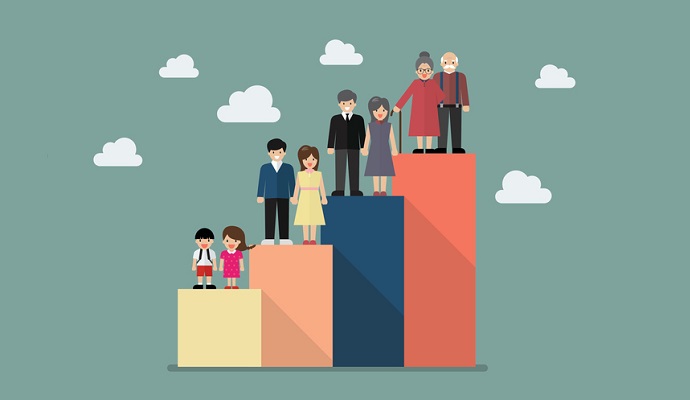February 6th, 2020
Sixty-one percent of people report social isolation, up 7 percentage points from last year’s figures.

People generations bar graph. Vector illustration
![]() By Sara Heath
By Sara Heath
Three in five adults experience loneliness and social isolation, pushing the social determinant of health and mental health challenge to its highest level on record, according to the 2020 Loneliness Index from Cigna.
Using survey data from over 10,400 adults and the UCLA Loneliness Scale, the 2020 Loneliness Index assesses self-reported and subjective feelings of loneliness or social isolation. Nearly 61 percent of all respondents reported to have at least some level of loneliness, which is a seven-percentage point increase from last year’s Index report.
This comes as 46 million individuals across the country experience another mental health issue, as well.
“The trends shaping how we work – increasing use of technology, more telecommuting and the always-on work culture – are leaving Americans more stressed, less rested, spending more time on social media, and less time with friends and family,” David M. Cordani, Cigna president and CEO, said in a press release. “For the business community, it is resulting in less engagement, less productivity and lower retention levels. To confront these issues at home and at work, we are helping people build stronger connections and driving deeper health engagement to improve overall well-being and vitality.”
The reasons for the increase in loneliness and social isolation are manifold, the Cigna researchers said. For one, individuals are reporting a smaller personal support system and few meaningful social interactions. Poor physical and mental health and limited lifestyle balance is also leading to an increase in the number of individuals experiencing loneliness.
READ MORE: ACP: Healthcare Needs Better Patient Care Access, SDOH Programs
Notably, the researchers identified a link between the loneliness increase and the work habits of the average American. Most individuals will complete nearly 90,000 hours of work across their lifetimes, and perhaps surprisingly, it’s those who work less than they’d like who are more apt to feel lonely.
Forty-nine percent of respondents said they work less often than they’d like and are nearly three points lonelier than those who work more than they’d like. Those who feel they do not work enough are six points lonelier than those who say they work just the right amount.
Other work-related factors are also swaying loneliness. People who don’t get on well with their coworkers are 10 points lonelier than those who do – and these individuals outnumber the people who get along with their coworkers.
Additionally, the nearly 51 percent of Americans who say they don’t have good work-life balance were almost seven points higher on the loneliness scale.
Employee loneliness is having a bad impact on business, Cigna added, with those who report loneliness being less productive, more likely to miss work, and less able to submit quality work.
READ MORE: FL Payer Unveils SDOH Program Targeting Social Isolation in Seniors
Cigna encouraged employers to foster better culture within their offices as a part of the payer’s efforts to address social isolation. Offices may promote a culture of openness, while pushing the use of technology to make connections with coworkers and other team-building activities.
Social isolation also proved more prevalent among different social demographics. Younger individuals, for example, tend to be more lonely than older generations. Nearly 80 percent of Generation Z and 70 percent of Millennials report loneliness, compared to just 50 percent of their Baby Boomer peers.
Men were more likely to report social isolation than women, as were those living in rural versus urban communities and those with low versus high incomes.
About 47 percent of Hispanic individuals and those identifying their race as “other” reported loneliness, while 46 percent of black patients reported the same. These demographics were more likely to experience social isolation than their white peers.
Social isolation can have serious health consequences, with notable studies suggesting that loneliness is equally dangerous to patient health as smoking 15 cigarettes. This social determinant of health demands attention from the medical community, to which Cigna is responding.
READ MORE: Payer Program Addresses Loneliness as Social Determinant of Health
Specifically, Cigna said it is broadening the services available to address mental health needs as well as expanding patient access to mental and behavioral health providers.
The payer also said it will enlist digital appointment scheduling tools to make it easier for members to connect with mental and behavioral health providers.
School-based mental and behavioral health options catered to students in middle and high school, as well as their parents and teachers, aim to mitigate this problem in the future by stemming it in childhood.
The Cigna Foundation will also be funneling $3 million over three years to drive mental and behavioral healthcare access in schools.
“With funding from the Cigna Foundation, we will help schools – and the communities that support them – combat increasingly prevalent mental health issues, such as loneliness and social isolation, anxiety, depression, bullying and violence, and better equip them with tools and resources to promote interpersonal connectivity, social support and resiliency,” said John Murabito, President of the Cigna Foundation and Executive Vice President of Cigna.


Comments are closed.